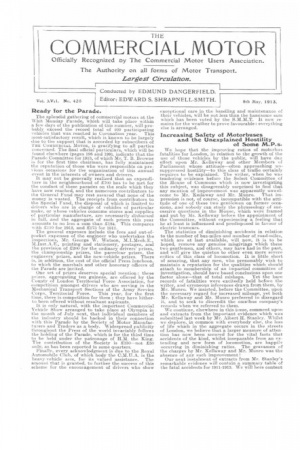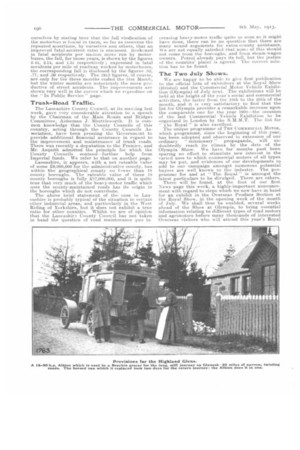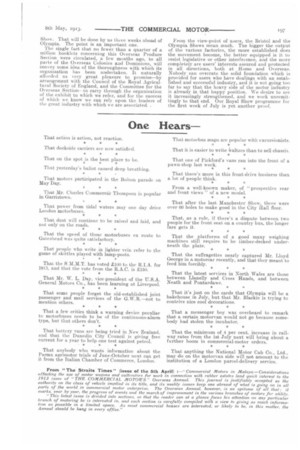Ready for the Parade.
Page 1

Page 2

Page 3

If you've noticed an error in this article please click here to report it so we can fix it.
The splendid gathering of commercial motors at the Whit Monday Parade, which will take place within a few days of the publication of this number, will probably exceed the record total of 400 participating vehicles that was reached in Coronation year. This most-satisfactory result, which is known to be largely due to the support that is accorded by subscribers of THE COMMERCIAL MOTOR, is gratifying to all parties concerned. The final official particulars, which will be found elsewhere (pages 198 and 199), indicate that the Parade Committee for 1913, of which Mr. T. B. Browne is for the first time chairman, has fully maintained the reputation of those who were responsible on previous occasions for the organization of this annual event in the interests of owners and drivers.
It may not be generally realized that an expenditure in the neighbourhood of £700 has to be met for the conduct of these parades on the scale which they have now reached, and the numerous contributors to the General Fund may rest assured that none of the money is wasted. The receipts from contributors to the Special Fund, the disposal of which is limited to drivers who are in charge of vehicles of particular make, or ANhose vehicles consume stores and supplies of particular manufacture, are necessarily disbursed in full, and the aggregate of such prizes this year amounts to no less a sum than £184. This compares with 2110 for 1912, and £173 for 1911.
The general expenses include the fees and out-ofpocket expenses of the engineer who undertakes the inspections, Mr. George W. Watson, M.I.Mech.E„ M.Inst.A.E., printing and stationery, pp-stages, and the provision of £200 for the ordinary drivers' prizes, the championship prizes, the parcelear prizes, the engineers' prizes, and the new-vehicle prizes. There is, in addition, the cost of the official Press luncheon, to which the marshals and other honorary officers of the Parade are invited.
One set of prizes deserves special mention : these prizes, aggregating ten guineas, are offered by the County of London Territorial Force Association, for competition amongst drivers who are serving in the Mechanical Transport Sections of the Army Service
Corps, Territorial Force. This year, for the first time, there is competition for them ; they have hitherto been offered without resultant aspirants.. It is only natural, with the important Commercial Vehicle Show arranged to take place at Olympia in the month of July next, that individual members of the industry should be backed in their connection with this Parade by the Society of Motor Manufacturers and Traders as a body. Widespread publicity throughout the Press of the world invariably follows the holding of the Parade, which is for the third time to be held under the patronage of H.M. the King. The contribution of the Society is 2150—not 250 only, as has been reported in some quarters.
Finally, every acknowledgment is due to the Royal Automobile Club, of which body the C.M.U.A. is the heavy-vehicle arm, for its valued assistance. The amount that is granted, to further the success of this scheme for the encouragement of drivers who show exceptional care in the handling and maintenance of their vehicles, will be not less than the handsome sum which has been voted by the S.M,M.T. It now remains for the weather to prove favourable : everything else is arranged.
Increasing Safety of Motorbuses a,nd the Unexplained Hostility
of Some M. P. s.
We hope that the improving ratios of motorbus fatalities for London, in relation to the growth of the use of those vehicles by the public, will have due effect upon Mr. lieLlaway and other Members of Parliament whose attitude—often approaching unsuppressed hostility—to this class of traffic certainly requires to be explained. The writer, when he was tendering evidence before the Select Committee of the House of Commons which is now investigating this subject, was disagreeably surprised to find that any mention of improvement was apparently unwelcome to Mr. Keilaway and Mr. Munro. That impression is not, of course, incompatible with the attitude of one of these two gentlemen on former occasions, and nobody can study the phraseology of successive questions in the House, which were framed and put by Mr. Kellaway before the appointment of the Committee, without experiencing a feeling that he at least is influenced and predisposed in favour of electric tramcars.
The statistics of diminishing accidents in relation to the number of bus-miles and number of road-miles, which are at last available, will now, it is to be hoped, remove any genuine misgivings which these two gentlemen, and others, may have had in the past, and will give the quietus to other even more severe critics of this class of locomotion. It is little short of amazing, that any men, who presumably wish to maintain a reputation for the qualities which should attach to membership of an impartial committee of investigation, should have based conclusions upon one factor alone—that of total mishaps. Yet the bare records of fatalities were excitedly held before the writer, and erroneous inferences drawn from them, by Mr. Munro. We insisted, before the Committee, upon the necessary regard for increased Mileage, yet both Mr. Kellaway and Mr. Munro preferred to disregard it, and to seek to discredit the omnibus company's records when we referred to them.
We continue, elsewhere in this issue, comment upon and extracts from the important evidence which was submitted last week by Mr. Albert H. Stanley. Whilst we deplore, in common with everybody else, the loss of life which in the aggregate occurs in the streets of London, we believe that a larger measure of attention has now been secured for the vital facts that accidents of the kind, whilst inseparable from at es:. tending and new form of locomotion, are happily occurring in diminishing ratios. The gravamen of the charges by Mr. Kellaway and Mr. Munro was the absence of any such improvement !
Our next instalment of extracts from Mr. Stanley's remarkable evidence will contain a summary table of the fatal accidents for 1911-1913. We will here content
ourselves by stating here that the full vindication of the motorbus is found in them, so far as concerns the repeated assertions, by ourselves and others, that an improved fatal-accident ratio is disclosed. ileckoned in fatal accidents per million miles run by motorbuses, the fall, for those years, is shown by the figures 2.44, 2.14, and 1.51 respectively ; expressed in fatal accidents per mile of roadway woiked by motorbuses, the corresponding fall is disclosed by the figures .82, .77, and .39 respectively. The 1913 figures, of course, are only for the three months ended the 31st March, but the winter months are notoriously the more productive of street accidents. The improvements are shown very well in the curves which we reproduce on the "In Public Service" page.
Trunk-Road Traffic.
The Lanca,shire County Council, at its meeting last week, gave very considerable attention to a speech by the Chairman of the Main Roads and Bridges Committee, Alderman J. Shuttleworth. It is common knowledge that the County Councils of this country, acting through the County Councils Association, have been pressing the Government to provide additional financial assistance in regard to the improvement and maintenance of trunk roads. There was recently a deputation to the Premier, and Mr. Asquith admitted the principle for which the County Councils contend----further help from Imperial funds. We refer to that on another page.
Lancashire, it appears, with a net rateable value of some £9,000,000 for the administrative county, has within the geographical county no fewer than 18 county boroughs. The rateable value of these 18 county boroughs is fully £17,000,000, and it is quite true that very much of the heavy-motor traffic which uses the county-maintained roads has its origin in the boroughs which do not contribute.
The above brief statement of the ease in Lancashire is probably typical of the situation in certain other industrial areas, and particularly in the West Riding of Yorkshire, but it does not exhibit a true ratio for other counties. Whilst we are of opinion that the Lancashire County Council has not taken in hand the question of road maintenance qua in
creasing heavy-motor traffic quite so soon as it might have done, there can be no question that there are many sound arguments for extra-county assistance. We are not equally satisfied that some of this should not come from the borcughs, and from steam-wagon owners. Petrol already pays its toll, but the justice of the counties' plaint is agreed. The correct solution has to be found.
The Two July Shows.
We are happy to be able to give first publication to the official lists of exhibitors at the Royal Show (Bristol) and the Commercial Motor Vehicle Exhibition (Olympia) of July next. The exhibitions will be held at the height of the year's social and commercial activities, the latter from the 18th to the 26th of the month, and it is very satisfactory to find that the list for Olympia provides a remarkable increase upon the comparable one for the year 1908—the occasion of the fast Commercial Vehicle Exhibition to be organized in London by the S.M.M.T. The list for '' The Royal" is also excellent.
The unique programme of THE COMMERCIAL MOTOR, which programme, since the beginning of this year, has been adopted and observed in extension of our ordinary " missionary" propaganda, will undoubtedly reach its climax by the date of the Olympia Show. We have for months past been sparing no effort to stimulate new intet est in the varied uses to which commercial motors of all types may be put, and evidences of our developments to add to our campaign amongst numerous potential buyers are well known to the industry. The programme for and at " The Royal" is amongst the latest particulars to be divulged. There are others.
There will be found, at the foot of our first News page this week, a highly-important announcement with regard to steps which we now have in hand for an exhibit in the Overseas Produce Section at the Royal Show, in the opening week of the month of July. We shall thus be enabled, several weeks ahead of the Show at Olympia, to bring essential information relating to different types of road motors and agiarnotors before many thousands of interested Overseas visitors who will attend this year's Royal Show. That will be done by us three weeks ahead of Olympia. The point is an important one. The single fact that no fewer than a quarter of a million booklets concerning this Overseas Produce Section were circulated, a few months ago, to all parts of the Overseas Colonies and Dominions, will convey some idea of the thoroughness with which its organization has been undertaken. It naturally afforded us very great pleasure to promise—by arrangement with the Council of the Royal Agricultural Society of England, and the Committee for the Overseas Section—to carry through the organization of the exhibit to which we refer, and for the success of which we know we can rely upon the leaders of the great industry with which we are associated. . From the view-point of users, the Bristol and the Olympia Shows mean much. The bigger the output of the various factories, the more established does the movement become, the better equipped is it to resist legislative or other interference, and the more completely are users' interests assured and protected in all directions, both at Home and Overseas. Nobody can overrate the solid foundation which is provided for users who have dealings with an established and successful industry, and it is not going too Far to say that the heavy side of the motor industry is already in that happy position. We desire to see it increasingly strengthened, and we work unremittingly to that end. Our Royal Show programme for the first week of July is yet another proof.


























